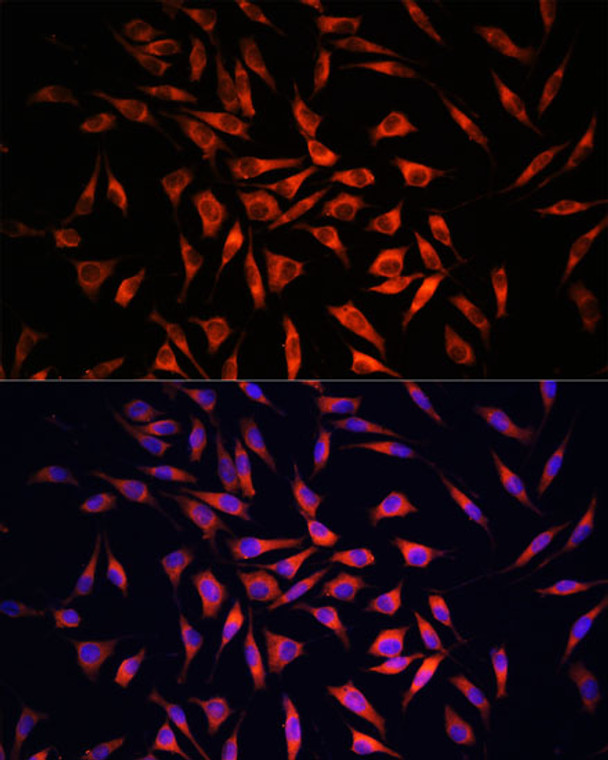| Host: |
Rabbit |
| Applications: |
WB/IF |
| Reactivity: |
Human/Mouse |
| Note: |
STRICTLY FOR FURTHER SCIENTIFIC RESEARCH USE ONLY (RUO). MUST NOT TO BE USED IN DIAGNOSTIC OR THERAPEUTIC APPLICATIONS. |
| Short Description: |
Rabbit polyclonal antibody anti-GSDMC (1-100) is suitable for use in Western Blot and Immunofluorescence research applications. |
| Clonality: |
Polyclonal |
| Conjugation: |
Unconjugated |
| Isotype: |
IgG |
| Formulation: |
PBS with 0.01% Thimerosal, 50% Glycerol, pH7.3. |
| Purification: |
Affinity purification |
| Dilution Range: |
WB 1:100-1:500IF/ICC 1:50-1:200 |
| Storage Instruction: |
Store at-20°C for up to 1 year from the date of receipt, and avoid repeat freeze-thaw cycles. |
| Gene Symbol: |
GSDMC |
| Gene ID: |
56169 |
| Uniprot ID: |
GSDMC_HUMAN |
| Immunogen Region: |
1-100 |
| Immunogen: |
Recombinant fusion protein containing a sequence corresponding to amino acids 1-100 of human GSDMC (NP_113603.1). |
| Immunogen Sequence: |
MPSMLERISKNLVKEIGSKD LTPVKYLLSATKLRQFVILR KKKDSRSSFWEQSDYVPVEF SLNDILEPSSSVLETVVTGP FHFSDIMIQKHKADMGVNVG |
| Tissue Specificity | Expressed mainly in trachea and spleen. In the esophagus, expressed in differentiating cells and probably in differentiated cells. Also detected in gastric epithelium. |
| Post Translational Modifications | Cleavage by CASP8 relieves autoinhibition by releasing the N-terminal moiety (Gasdermin-C, N-terminal) that initiates pyroptosis. The cleavage site is unclear. According to a publication, it takes place after Asp-240 in response to alpha-ketoglutarate. Another paper reports cleavage by CASP8 after Asp-365. |
| Function | Gasdermin-C: This form constitutes the precursor of the pore-forming protein: upon cleavage, the released N-terminal moiety (Gasdermin-C, N-terminal) binds to membranes and forms pores, triggering pyroptosis. Gasdermin-C, N-terminal: Pore-forming protein that causes membrane permeabilization and pyroptosis. Produced by the cleavage of gasdermin-D by caspase CASP8 in response to death signals. After cleavage, moves to the plasma membrane where it strongly binds to membrane inner leaflet lipids. Homooligomerizes within the membrane and forms pores of 10-15 nanometers (nm) of inner diameter, triggering pyroptosis. |
| Protein Name | Gasdermin-CMelanoma-Derived Leucine Zipper-Containing Extranuclear Factor Cleaved Into - Gasdermin-C - N-TerminalGsdmc-Nt - Gasdermin-C - C-TerminalGsdmc-Ct |
| Cellular Localisation | Gasdermin-C: CytoplasmCytosolGasdermin-CN-Terminal: Cell MembraneMulti-Pass Membrane Protein |
| Alternative Antibody Names | Anti-Gasdermin-C antibodyAnti-Melanoma-Derived Leucine Zipper-Containing Extranuclear Factor Cleaved Into - Gasdermin-C - N-Terminal antibodyAnti-Gsdmc-Nt - Gasdermin-C - C-Terminal antibodyAnti-Gsdmc-Ct antibodyAnti-GSDMC antibodyAnti-MLZE antibody |
Information sourced from Uniprot.org
12 months for antibodies. 6 months for ELISA Kits. Please see website T&Cs for further guidance








